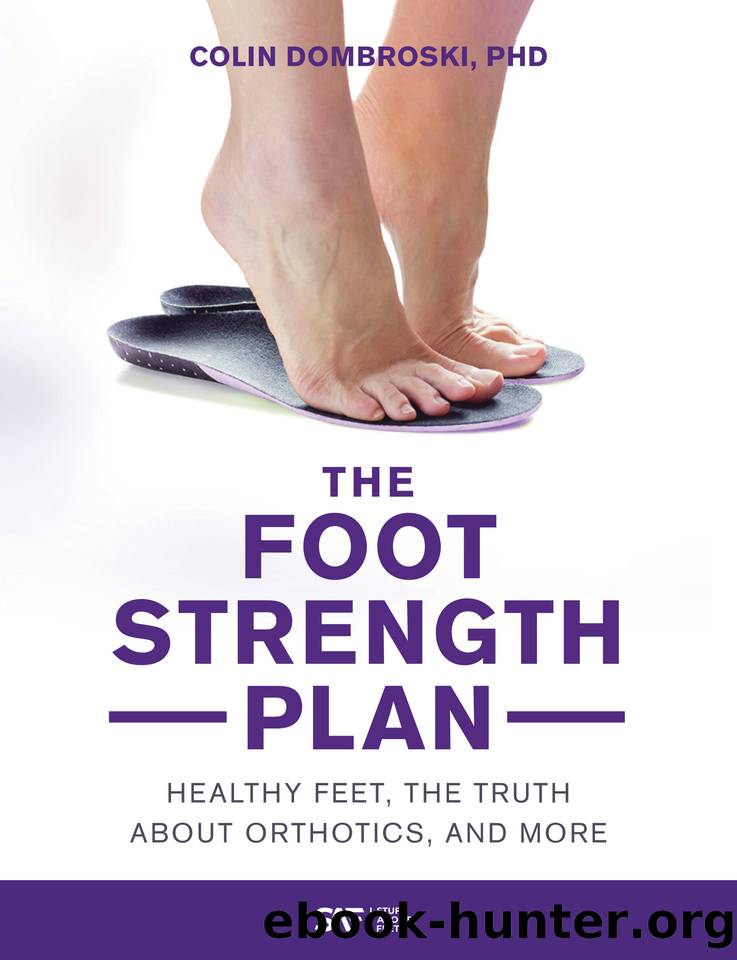The Foot Strength Plan: Healthy Feet, the Truth About Orthotics, and More by Dombroski PhD Colin

Author:Dombroski PhD, Colin [Dombroski PhD, Colin]
Language: eng
Format: epub
Publisher: Stuff About Feet, Inc.
Published: 2021-02-23T16:00:00+00:00
CHAPTER FIVE
STEP ONE: MOBILITY
Flexibility vs. Mobility
To avoid injury, you need to have both flexibility and mobility in your feet and ankles. Letâs define these two words.
Flexibility: the ability of your muscle(s) to lengthen.
Mobility: your ability to move a joint through its intended full range of motion with strength in a functional way.
Flexibility is important for proper joint mobility. To develop flexibility without regard for mobility is asking for trouble, though. Itâs possible to have great flexibility and poor mobility. Hamstrings can be flexible when testing them, and due to instability somewhere else higher up the chain, for instance with an unstable pelvis or bad posture, be overactive and tighten during gait, affecting the ability to touch oneâs toes. As we age, our range of motion naturally decreases. You can counteract that natural tendency by staying fit and doing things like yoga that help keep you flexible and your joints mobile. This will really help reduce the likelihood of injury.
One of the most deleterious losses of mobility I see day to day is the loss of range of motion at the ankle. This loss of mobility can lead to decreased stability and increases the loads on both the plantar fascia and the Achilles tendon. Similarly, if your calf muscles arenât sufficiently flexible to allow your leg to move over the top of your foot when you walk, your body compensates for the movement somewhere else. The easiest way to compensate is to pronate your foot (roll it in) or raise your heel prematurely, or some combination thereof. That puts even more strain on your lower extremities.
Your feet canât work properly if youâre duck-footed (where your feet rotate externally), so work on fixing that first.
Mobility Exercises to Get the Ankle Moving Better
Do you walk like a duck? Do your feet turn outward when you walk (external rotation)? (Image 4)
Can you extend your leg and easily point your toes back toward your shins? (Image 5)
This movement is called âdorsiflexion.â (Pointing your toes down, away from your ankle, is called âplantarflexion.â) If you have a reduction in the dorsiflexion of the ankle, it usually comes from tight calf muscles or some type of restriction in the ankle, such as bone deformity or a build up of scar tissue.
Download
This site does not store any files on its server. We only index and link to content provided by other sites. Please contact the content providers to delete copyright contents if any and email us, we'll remove relevant links or contents immediately.
| Administration & Medicine Economics | Allied Health Professions |
| Basic Sciences | Dentistry |
| History | Medical Informatics |
| Medicine | Nursing |
| Pharmacology | Psychology |
| Research | Veterinary Medicine |
Periodization Training for Sports by Tudor Bompa(7918)
Why We Sleep: Unlocking the Power of Sleep and Dreams by Matthew Walker(6352)
Paper Towns by Green John(4796)
The Immortal Life of Henrietta Lacks by Rebecca Skloot(4255)
The Sports Rules Book by Human Kinetics(4078)
Dynamic Alignment Through Imagery by Eric Franklin(3919)
ACSM's Complete Guide to Fitness & Health by ACSM(3823)
Kaplan MCAT Organic Chemistry Review: Created for MCAT 2015 (Kaplan Test Prep) by Kaplan(3800)
Introduction to Kinesiology by Shirl J. Hoffman(3626)
Livewired by David Eagleman(3534)
The River of Consciousness by Oliver Sacks(3417)
The Death of the Heart by Elizabeth Bowen(3337)
Alchemy and Alchemists by C. J. S. Thompson(3294)
Descartes' Error by Antonio Damasio(3165)
Bad Pharma by Ben Goldacre(3095)
The Emperor of All Maladies: A Biography of Cancer by Siddhartha Mukherjee(2928)
The Gene: An Intimate History by Siddhartha Mukherjee(2927)
The Fate of Rome: Climate, Disease, and the End of an Empire (The Princeton History of the Ancient World) by Kyle Harper(2870)
Kaplan MCAT Behavioral Sciences Review: Created for MCAT 2015 (Kaplan Test Prep) by Kaplan(2815)
